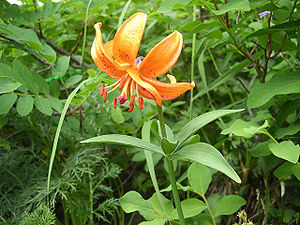Lilium medeoloides
| Lilium medeoloides | ||||||||||||
|---|---|---|---|---|---|---|---|---|---|---|---|---|

Lilium medeoloides |
||||||||||||
| Systematics | ||||||||||||
|
||||||||||||
| Scientific name | ||||||||||||
| Lilium medeoloides | ||||||||||||
| A.Gray |
Lilium medeoloides is a species from the genus of lilies ( Lilium ) in the Martagon section .
description
The approximately round onion has a diameter of 2 to 2.5 centimeters and is made up of white, elongated-lanceolate, loose scales that are 1 to 2 centimeters long and 3 to 4 millimeters wide. The smooth, rarely weakly papillary stem is 30 to 75 (rarely up to 100) centimeters long, on it the leaves stand in whorls of seven to twelve (rarely up to twenty) pieces, in addition there are a few single leaves distributed over the stem. The hairless leaves, slightly rough at the edge, are elongated-lanceolate to inverted-lanceolate, taper to a point and are 5 to 12 (rarely up to 17) centimeters long and 1.5 to 4 centimeters wide.
Flowering time is from July to August. The inflorescence is either a single flower or an umbel or cluster consisting of two to four (rarely up to ten) nodding, non-scented flowers . The lanceolate, thick bracts are strongly bent back, apricot-colored to light red with black dots, only papillary at the tip, 3.5 to 4 (3 to 4.5) centimeters long and 5 to 10 millimeters wide. The stamens are shorter than the bracts, the stamens glabrous, the anthers around 1 centimeter long. The ovary is about 1 centimeter long, the stylus is thickened occasionally toward the tip. The capsule is inverted ovate, three-way and 1.5 to 2 inches long.
The number of chromosomes is 2n = 24.
distribution
Lilium medeoloides is native to the People's Republic of China ( Zhejiang ), Japan , Korea ( Jeju-do ) and Russia ( Kamchatka , Kuril Islands , Sakhalin ) and appreciates partially shaded, fresh locations. It grows in forests on moist slopes, between bushes, near rivers and between tall grasses on subalpine meadows on moist and humus-rich limestone and silicate soils. Starting from stands on meadows and in forests, the species is occasionally also found in neighboring rocky vegetation.
Systematics and botanical history
Lilium medeoloides belongs to the Martagon section within the lilies . It is closely related to Lilium tsingtauense and Lilium debile , the latter was often treated as synonymous with Lilium medeoloides . Synonyms are Lilium avenaceum fish. ex rule and Lilium sado-insulare Masam. & Satomi . The species was discovered in 1853 on Hokkaidō (Japan) by Charles Wright and first described by Asa Gray in 1859 , the holotype is in the Gray Herbarium of Harvard University . Lilium medeoloides had been a popular garden plant in Japan for centuries, but it was not until 1864 that it was also cultivated in the West.
swell
- Mark Wood: Lily Species - Notes and Images. CD-ROM. Version dated July 13, 2006.
literature
- Flora of China. Volume 24, p. 138
Individual evidence
- ^ Tropicos. [1]
- ↑ Rafaël Govaerts (ed.): Lilium medeoloides. In: World Checklist of Selected Plant Families (WCSP) - The Board of Trustees of the Royal Botanic Gardens, Kew . Retrieved April 25, 2020.
